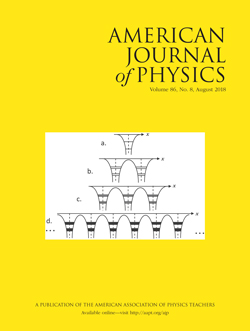August 2018 Issue, Volume 86, No. 8
A classical analogy for quantum band formation
Electrons in an atom are confined to distinct, quantized energy levels. When atoms form solids, the interaction of the electrons causes their energy levels to split into multiple closely spaced levels, or bands, separated by forbidden regions called band gaps. Each band contains a number of energy levels equal to the number of atoms in the solid. This model of the origin of band structure can be reproduced by using a classical array of harmonic oscillators (masses connected by springs). In this system, each oscillator plays the role of an atom and its resonant frequencies play the roles of electronic energy levels. When coupled, a system of oscillators yields a spectrum of resonant frequencies and when the number of oscillators becomes sufficiently large, the system exhibits the formation of “resonant frequency bands,” similar in structure to the energy bands of an atomic solid. We experimentally demonstrate band formation using coupled harmonic oscillators and highlight the effects of both number of oscillators and coupling strength on the band structure. Additionally, we show that experimental results of this band formation follow a theoretical analysis of the system.
Papers
Resource Letter GECC-1: The Greenhouse Effect and Climate Change: Earth's Natural Greenhouse Effect by Stephen E. Schwartz. DOI: 10.1119/1.5045574.
Combined viscous and dry friction damping of oscillatory motion by Peter F. Hinrichsen, and Chris I. Larnder. DOI: 10.1119/1.5034345.
The apparent (gravitational) horizon in cosmology by Fulvio Melia. DOI: 10.1119/1.5045333.
Using a shoebox spectrograph to investigate the differences between reflection and emission by Timothy T. Grove, Jacob Millspaw, Eric Tomek, Rebeca Manns, Mark Masters. DOI: 10.1119/1.5045205.
A simple method of coil design by M. Rawlik, A. Eggenberger, J. Krempel, C. Crawford, K. Kirch, F. M. Piegsa, G. Quéméner. DOI: 10.1119/1.5042244.
A classical analogy for quantum band formation by Parker Roberts, Alexandria Skinner, Tadan Cobb, Scott Carr, and Shawn A. Hilbert. DOI: 10.1119/1.5045332.
Computational Physics
Learning universality and scaling from simple deposition models by Alessandro Santini, and Paolo Politi. DOI: 10.1119/1.5041372.
Notes and Discussions
A compact general expression for momentum exchange in elastic collisions by B. Cameron Reed. DOI: 10.1119/1.5042753.
Apparatus and Demonstration Notes
Non-radiative mid-range wireless power transfer: An experiment for senior physics undergraduates by S. D. Delichte, Y. J. Lu, and J. S. Bobowski. DOI: 10.1119/1.5037705.
Versatility of electrochemically grown dendrites in the undergraduate laboratory by S. Tuppan, D. Dams, Z. Olson, and W. J. Kim. DOI: 10.1119/1.5040499
Book Reviews
Precise Dimensions: A History of Units from 1791–2018 by Terry Quinn. DOI: 10.1119/1.5040579.
Books Received
American Journal of Physics 86, 640 (2018); . DOI: 1.5045199.
About AJP
General Information, Resources for Authors, Reviewers, and Readers

